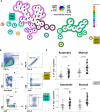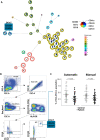CRB1-Associated Retinal Dystrophy Patients Have Expanded Lewis Glycoantigen-Positive T Cells
- PMID: 37792335
- PMCID: PMC10565706
- DOI: 10.1167/iovs.64.13.6
CRB1-Associated Retinal Dystrophy Patients Have Expanded Lewis Glycoantigen-Positive T Cells
Abstract
Purpose: Eye inflammation may occur in patients with inherited retinal dystrophies (IRDs) and is seen frequently in IRDs associated with mutations in the CRB1 gene. The purpose of this study was to determine the types of inflammatory cells involved in IRDs, by deep profiling the composition of peripheral blood mononuclear cells of patients with a CRB1-associated IRD.
Methods: This study included 33 patients with an IRD with confirmed CRB1 mutations and 32 healthy controls. A 43-parameter flow cytometry analysis was performed on peripheral blood mononuclear cells isolated from venous blood. FlowSOM and manual Boolean combination gating were used to identify and quantify immune cell subsets.
Results: Comparing patients with controls revealed a significant increase in patients in the abundance of circulating CD4+ T cells and CD8+ T cells that express sialyl Lewis X antigen. Furthermore, we detected a decrease in plasmacytoid dendritic cells and an IgA+CD24+CD38+ transitional B-cell subset in patients with an IRD.
Conclusions: Patients with a CRB1-associated IRD show marked changes in blood leukocyte composition, affecting lymphocyte and dendritic cell populations. These results implicate inflammatory pathways in the disease manifestations of IRDs.
Conflict of interest statement
Disclosure:
Figures




Similar articles
-
Elevated Plasma Complement Factors in CRB1-Associated Inherited Retinal Dystrophies.Invest Ophthalmol Vis Sci. 2025 Feb 3;66(2):55. doi: 10.1167/iovs.66.2.55. Invest Ophthalmol Vis Sci. 2025. PMID: 39982393 Free PMC article.
-
CRB1-Related Retinal Dystrophies in a Cohort of 50 Patients: A Reappraisal in the Light of Specific Müller Cell and Photoreceptor CRB1 Isoforms.Int J Mol Sci. 2021 Nov 23;22(23):12642. doi: 10.3390/ijms222312642. Int J Mol Sci. 2021. PMID: 34884448 Free PMC article.
-
Detection of CRB1 mutations in families with retinal dystrophy through phenotype-oriented mutational screening.Int J Mol Med. 2014 Apr;33(4):913-8. doi: 10.3892/ijmm.2014.1655. Epub 2014 Feb 12. Int J Mol Med. 2014. PMID: 24535598
-
[Genotype-Phenotype Correlations in Patients with CRB1 Mutations].Klin Monbl Augenheilkd. 2017 Mar;234(3):289-302. doi: 10.1055/s-0043-103961. Epub 2017 Mar 29. Klin Monbl Augenheilkd. 2017. PMID: 28355663 Review. German.
-
CRB1: one gene, many phenotypes.Semin Ophthalmol. 2013 Sep-Nov;28(5-6):397-405. doi: 10.3109/08820538.2013.825277. Semin Ophthalmol. 2013. PMID: 24138049 Review.
Cited by
-
Elevated Plasma Complement Factors in CRB1-Associated Inherited Retinal Dystrophies.Invest Ophthalmol Vis Sci. 2025 Feb 3;66(2):55. doi: 10.1167/iovs.66.2.55. Invest Ophthalmol Vis Sci. 2025. PMID: 39982393 Free PMC article.
References
Publication types
MeSH terms
Substances
LinkOut - more resources
Full Text Sources
Research Materials
Miscellaneous

